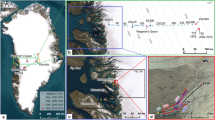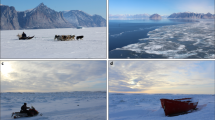Abstract
For the Cree First Nation communities of the eastern James Bay region in the Canadian Subarctic, local weather plays a key role in traditional subsistence activities. There is rising concern among the Cree about changes in inland ice conditions as they pose challenges to Cree livelihood, health and culture. Here we contrast Crees’ observations of inland ice conditions and long-term measurements obtained to foster interdisciplinary climate change research between scientists and Cree communities. We compiled qualitative observations of inland ice conditions and compared them with long-term measurements (> 25 years) of air temperature, precipitation and snow depth from three meteorological stations in the Cree territory. Cree hunters observed a weakening of lake ice cover (e.g., change in ice composition and structure, increased rain in winter). Trend analysis of long-term measurements showed a significant increase in mean autumn air temperature as well as in winter and autumn precipitation. By contrasting Cree hunters’ observations with climate data, we identified that an increase in fall and winter precipitation could be causing a weakening of inland ice through a change in its composition (i.e., snow ice instead of congelation ice). We conclude that Cree and scientific knowledge are complementary when investigating and understanding climate change in the Subarctic.



Similar content being viewed by others
References
Adams WP, Roulet NT (1980) Illustration of the roles of snow in the evolution of the winter cover of a lake. Arctic 33(1):100–116
Andrachuk M, Smit B (2012) Community-based vulnerability assessment of Tuktoyaktuk, NWT, Canada to environmental and socio-economic changes. Regional Environmental Change : 1–19. DOI: 10.1007/s10113-012-0299-0
Anonymous (2010a) In-depth interview in Mistissini, Québec. Interviewed by: Marie-Jeanne Royer, August 2010
Anonymous (2010b) Short interview in Mistissini, Québec. Interviewed by: Marie-Jeanne Royer, August 2010
Anonymous (2010c) Short interview in Nemaska, Québec. Interviewed by: Marie-Jeanne Royer, August 2010
Anonymous (2010d) Short interview in Eastmain, Québec. Interviewed by: Marie-Jeanne Royer, August 2010
Ashton GD (ed) (1986) River & lake ice engineering. Water Resources Publication, USA
Berkes F, Colding J, Folke C (2000) Rediscovery of traditional ecological knowledge as adaptive management. Ecol Appl 10:1251–1262
Biernacki P, Waldorf D (1981) Snowball sampling: problems and techniques of chain referral sampling. Sociol Methods Res 10:141–163
Bronaugh D, Werner A (2009) zyp: Zhang + Yue-Pilon trends package. R package version 0.9-1. http://www.r-project.org
Brown RD (2010) Analysis of snow cover variability and change in Quebec, 1948–2005. Hydrol Process 24(4):1929–1954
Cavaliere C (2009) The effects of climate change on medicinal and aromatic plants. Herbal Gram 81:44–57
Collins M (2005) Caractérisation des tourbières et suivi historique des unités morphologiques de surface en lien avec le climat dans le basin versant de la rivière La Grande. M.S. thesis, Dép. de Géographie, Université du Québec à Montréal, Montréal, Canada
Costello A, Abbas M, Allen A, Ball S, Bell S, Bellamy R et al (2009) Managing the health effects of climate change. The Lancet 373:1693–1733
Cree Board of Health and Social Services of James Bay (CBHSSJB) (2010) Drowning in Eeyou Istchee. An overview of the death and hospitalization statistics, 1985–2007. http://www.creehealth.org/sites/default/files/Drowning%20factsheet.pdf
Cree Trappers’ Association (CTA) Objects of the Cree Trappers’ Association. The Incorporation Papers of the Association recorded March 31, 1978, [Online] http://creetrappers.ca/objects.php.
Cree Trappers’Association (CTA) (2009) Traditional Eeyou Hunting Law. Unpublished, Eastmain, Canada
Czernochowski D, Mecklinger A, Johansson M, Brinkmann M (2005) Age-related differences in familiarity and recollection: ERP evidence from a recognition memory study in children and young adults. Cogn Affective Behav Neurosci 5(4):417–433
R Development Core Team, 2009. R: A language and environment for statistical computing. R Foundation for statistical computing, Vienna, ISBN: 3-900051- 07–0. http://www.R-project.org
Downing A, Cuerrier A (2011) A synthesis of the impacts of climate change on the First Nations and Inuit of Canada. Indian J Tradit Knowl 10(1):57–70
Dyck MG (2007) Community monitoring of environmental change: college-based limnological studies at Crazy Lake (Tasirluk), Nunavut. Arctic 60(1):55–61
Environment Canada (2011) Normales et moyennes climatiques au Canada 1971–2000. http://www.climate.weatheroffice.gc.ca/climate_normals/index_f.html. Accessed 1 October 2011
Feit HA (1991) Gifts of the land: hunting territories, guaranteed incomes and the construction of social relations in James Bay Cree society. Senri Ethnol Stud 30:223–268
Ford JD (2009) Vulnerability of Inuit food systems to food security as a consequence of climate change: a case study from Igloolik, Nunavut. Reg Environ Chang 9(2):83–100
Ford JD, Berrang-Ford L, King M, Furgal C (2010) Vulnerability of aboriginal health systems in Canada to climate change. Glob Environ Chang 20:668–680
Furgal C, Prowse T (2008) Northern Canada. In: Lemmen DS, Warren FJ, Lacroix J, Bush E (eds) From impacts to adaptation: Canada in a Changing Climate 2007. Government of Canada, Ottawa, pp 57–118
Furgal C, Seguin J (2006) Climate change, health and vulnerability in Canadian northern aboriginal communities. Environ Heal Perspect 114(1):1964–1970
Gagnon AS, Gough WA (2005) Trends in the dates of ice freeze-up and break-up over Hudson Bay, Canada. Arctic 58:370–382
Gearheard S, Matumeak W, Angutikjuaq I, Maslanik J, Huntington HP, Levitt J, Kagak DM, Tigullaraq G, Barry RG (2006) “It’s not that simple”: A collaborative comparison of sea ice environments, their uses, observed changes, and adaptations in barrow, Alaska, USA, and Clyde River, Nunavut, Canada. Ambio 35:203–211
Gearheard S, Pocernich M, Stewart R, Sanguya J, Huntington HP (2010) Linking Inuit knowledge and meteorological station observations to understand changing wind patterns at Clyde River, Nunavut. Clim Chang 100:267–294
Ghetti S, Angelini L (2008) The development of recollection and familiarity in childhood and adolescence: evidence from the dual-process signal detection model. Child Dev 79(2):339–358
Herrmann TM, Royer MJS, Cuciurean R (2012) Understanding subarctic wildlife in Eastern James Bay under changing climatic and socio-environmental conditions: bringing together Cree hunters’ ecological knowledge and scientific observations, Polar Geography. doi:10.1080/1088937x.2011.654356
Hirsch RM, Slack JR, Smith RA (1982) Techniques of trend analysis for monthly water quality data. Water Resour Res 18:107–121
Huntington HP (2000) Native observations capture impacts of sea ice changes. Witn Arct 8(1):1–2
Jones JAA (1969) The growth and significance of white ice at Knob Lake, Quebec. Can Geogr 13(4):354–372
Kendall, MG, Gibbons, JD (1990) Rank correlation methods. London: E. Arnold
Krupnik I, Jolly D (eds) (2002) The earth is faster now. ARCUS, Fairbanks
Laidler GJ, Ford JD, Gough WA, Ikummaq T, Gagnon AS, Kowal S, Qrunnut K, Irngaut C (2009) Travelling and hunting in a changing Arctic: assessing Inuit vulnerability to sea ice change in Igloolik, Nunavut. Clim Chang 94:363–397
Laidler GJ, Elee P, Ikummaq T, Joamie E, Aporta C (2010) Mapping Sea-ice knowledge, use, and change in Nunavut, Canada (Cape Dorset, Igloolik, Pangnirtung). In: Krupnik I, Aporta C, Gearheard S, Laidler GJ, Kielsen-Holm L (eds) SIKU: Knowing our ice, documenting Inuit sea-ice knowledge and use. Springer, Dordrecht
Magnuson JJ, Robertson DM, Benson BJ, Wynne RH, Livingstone DM, Arai T, Assel RA, Barry RG, Card V, Kuusisto E, Granin NG, Prowse TD, Stewart KM, Vuglinski (2000) Historical trends in lake and river ice cover in the Northern Hemisphere. Science 289(5485):1743–1746
Mays N, Pope C (1995) Qualitative research: rigour and qualitative research. BMJ 311:109
McDonagh P (2011) Observing the effects of climate change in Eeyou Istchee. Public Health Department of the Cree Health Board, [Online] http://www.creehealth.org/news/observing-effects-climate-change-eeyou-istchee. Accessed 25 November 2011
Morantz T (1978) The probability of family hunting territories in eighteenth century James Bay: Old evidence newly presented. In: Cowan W (ed) Proceedings of the Ninth Algonquian Conference. Carleton University, Ottawa
Moser SC (2010) Now more than ever: the need for more societally relevant research on vulnerability and adaptation to climate change. Appl Geogr 30:464–474
Nichols T, Berkes F, Jolly D, Snow NB, the community of Sachs Harbor (2004) Climate change and sea ice: local observations from the Canadian western Arctic. Arctic 57(1):68–79
Niezen R (1993) Telling a message: Cree perceptions of custom and administration. Can J Nativ Stud 13(2):221–250
Ohmagari K, Berkes F (1997) Transmission of indigenous knowledge and bush skills among the Western James Bay Cree women of Subarctic Canada. Hum Ecol 25(2):197–222
Palecki MA, Barry RG (1986) Freeze-up and break-up of lakes as an index of temperature changes during transition seasons: a case study for Finland. J Appl Meteorol 25(7):893–902
Parkinson AJ, Evengard B (2009) Climate change, its impact on human health in the Arctic and the public health response to threats of emerging infectious disease. Climate Change and Infectious Diseases. Glob Health Action. doi:10.3402/gha.v210.2075
Pearce TD, Ford JD, Laidler GT, Smit B, Duerden F, Allarut M, Andrachuk M, Baryluk S, Daila A, Elee P, Goose A, Ikummaq T, Joamie E, Kataoyak F, Loring E, Meakin S, Nickels S, Shappa K, Shirley J, Wandel J (2009) Community collaboration and climate change research in the Canadian Arctic. Polar Res 28:10–27
Peloquin C, Berkes F (2010) Local knowledge and changing subsistence strategies in James Bay, Canada. In: Bates DG, Tucker J (eds) Human ecology: Contemporary research and practice. Springer, New York
Power EM (2008) Conceptualizing food security for aboriginal people in Canada. Can J Publ Health March-April 95–97
Royer MJS, Herrmann TM (2011) Socio-environmental changes in two traditional food species of the Cree First Nation of subarctic James Bay, Cahiers de géographie du Québec 55(156):575–601
Salisbury RF (1986) A homeland for the Cree, regional development in James Bay 1971–1981. McGill-Queen’s University Press, Kingston and Montreal
Sayles JS, Mulrennan ME (2010) Securing a future: Cree hunters’ resistance and flexibility to Environmental changes, Wemindji, James Bay. Ecology and Society 15(4):22, http://www.ecologyandsociety.org/vol15/iss4/art22/
Scott CH (1986) Hunting territories, hunting bosses and communal production among coastal James Bay Cree. Anthropologica 28(1–2):163–173
Secrétariat aux affaires autochtones (2009) Profile of the Nations: Crees. http://www.autochtones.gouv.qc.ca/relations_autochtones/profils_nations/cris_en.htm Accessed 14 May 2011
Sen PK (1968) Estimates of the regression coefficient based on Kendall’s tau. J Am Stat Assoc 63:1379–1389
Statistics Canada, 2006: Population reporting an Aboriginal identity, by mother tongue, provinces and territories. http://www40.statcan.ca/l01/cst01/demo38a-eng.htm Accessed 14 May 2011
Symon C, Arris L, Heal B (2005) Arctic climate impact assessment. Cambridge University Press, Cambridge
Tam B, Gough WA, Tsuji L (2011) The impact of warming on the appearance of furunculosis in the fish of the James Bay region, Quebec, Canada. Reg Environ Chang 11:123–132
Tanner A (1983) Algonquin land tenure and state structures in the North. Can J Nativ Stud 3(2):11–320
Tanner A (2007) The nature of Quebec Cree animist practices and beliefs. In: Laugrand FB, Oosten JG (eds) La nature des esprits dans les cosmologies autochtones. Les Presses de l’Université de Laval, Québec
Turner N, Clifton H (2009) It’s so different today: climate change and indigenous lifeways in British Columbia, Canada. Glob Environ Chang 19:180–190
US Army Corps of Engineers (USACE) (2002) Engineering and design: Ice engineering. Department of the Army, Washington
US Army Corps of Engineers (USACE) (1996) Ice Thickness and Strength for Various Loading Conditions. USA, http://www.mvp-wc.usace.army.mil/ice/ice_load.html, Accessed 28 February 2013
Weatherhead E, Gearheard S, Barry RG (2010) Changes in weather persistence: insights from Inuit knowledge. Glob Enviorn Chang 20:523–528
Yagouti A, Boulet G, Vincent LA, Vescovi L, Mekis É (2008) Observed changes in daily temperature and precipitation indices for Southern Quebec, 1960–2005. Atmosphere-Ocean 46(2):243–256
Yue S, Pilon P, Phinney B, Cavadias G (2002) The influence of autocorrelation on the ability to detect trend in hydrological series. Hydrol Process 16:1807–1829
Acknowledgments
The authors are most thankful to the insights and generous hospitality provided by the members of the CTA. This research was supported with funding from DIALOG, the Canada Research Chair in Ethnoecology and Biodiversity Conservation, and the Université de Montréal. We also wish to thank M. Marc Girard of the Université de Montréal and M. Gerry Marsh for their contributions to this paper.
Author information
Authors and Affiliations
Corresponding author
Rights and permissions
About this article
Cite this article
Royer, MJ.S., Herrmann, T.M., Sonnentag, O. et al. Linking Cree hunters’ and scientific observations of changing inland ice and meteorological conditions in the subarctic eastern James Bay region, Canada. Climatic Change 119, 719–732 (2013). https://doi.org/10.1007/s10584-013-0773-9
Received:
Accepted:
Published:
Issue Date:
DOI: https://doi.org/10.1007/s10584-013-0773-9




